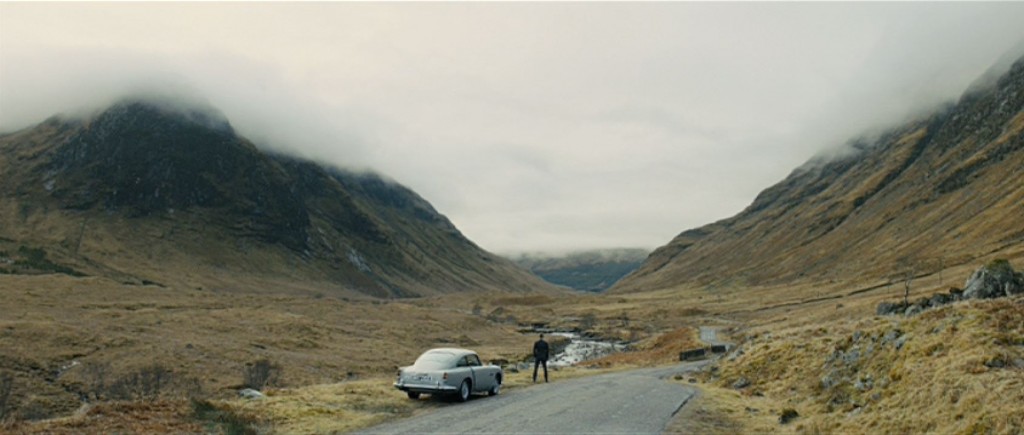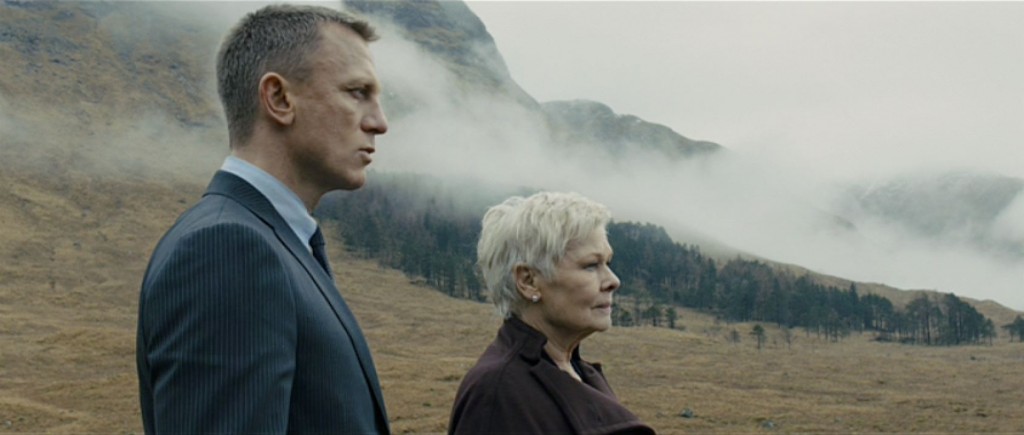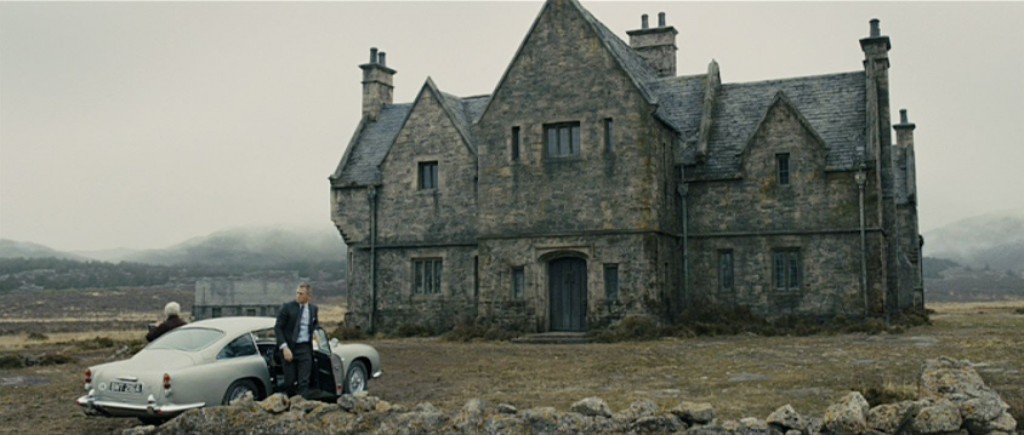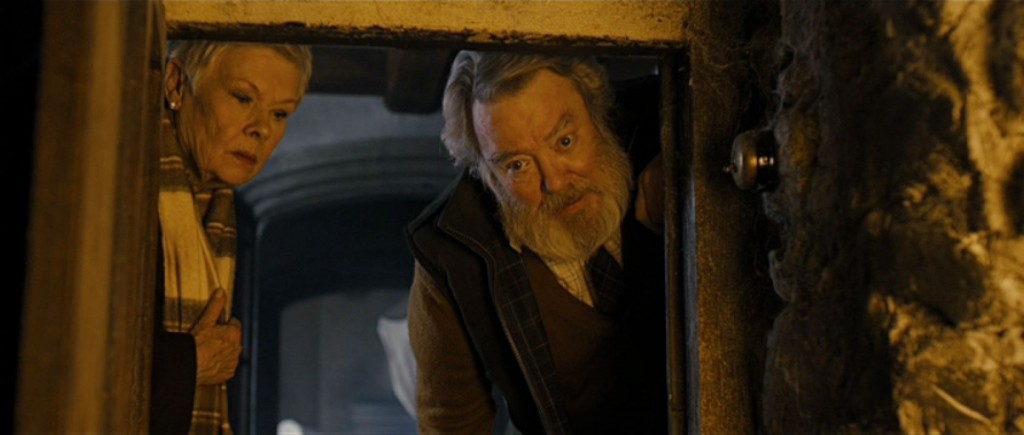James Bond: Skyfall part 8
Act IV of Skyfall begins at 1:45:49 and opens with a stunning shot of Bond, with his Goldfinger car, as a tiny figure in a huge landscape, fitting as Skyfall‘s primary goal is to place the Craig Bond in context, not just in the Bond-verse but in the cultural landscape. The narrative asks “How does James Bond fit into the modern world of espionage?” but what it’s really asking is how he fits into the modern world at all. And I don’t think I’m “bringing this” to the movie, I think it’s quite intentional. The Bond movies have never, ever seriously asked us to consider the world of real-life espionage at all, they’ve always been colorful, absurd, high-flown escapist spectacles, the Batman of espionage thrillers. They didn’t offer a solution to the Cold War, they offered escape from it, they goofed on it.
And so, as with Batman, Bond must now be re-imagined, brought to earth, scaled back and made a resonant character. I’m not a grade-A cultural analyst, but one thing I’ve noticed in the past decade is that everyone has an opinion on Bond, and must have an opinion on Bond, and must be prepared to discuss and defend those opinions, and must be prepared to offer logical reasons why they prefer Dalton to Brosnan or why The Spy Who Loved Me is better than Thunderball or why Nick Nack is better than Tee Hee, all in spite of the fact that it’s all quite silly. James Bond, for some bizarre reason, bless his heart, matters to us as a culture. He obviously means something.
I think the cultural shift regarding Bond is the same shift that has presented itself to straight white men everywhere: he’s no longer in charge of everything, and the world is no longer his red carpet. Watching You Only Live Twice the other day, I was struck by how the whole narrative just unrolls for Bond to step into. There’s a scene where Japanese super-spy Tiger Tanaka takes Bond to his gigantic Ninja Training Camp, an idea silly enough by itself, but sillier still is the way it’s presented to Bond: here is a gigantic ninja training camp, we are all here to help you, do what you like with us. Guns, gadgets, vehicles, women, travel are all thrust toward the Connery Bond with the flourish of a fruit basket in a penthouse suite for a VIP. “Right this way, Mr. Bond, your fantasy adventure awaits you for you to partake.”
With rare exceptions, the Bond movies are nothing but fantasy comedies for middle-aged men with adolescent minds (which is why Roger Moore kept being cast long past his sell-by date – Bond on paper may be a young man, but Moore was the audience). The typical Bond plot falls apart with only a cursory glance and has the visual panache of a 50s Batman story: giant props, garish villains, shark tanks, volcano strongholds, indestructible henchmen. In On Her Majesty’s Secret Service Bond leads a chase into a stock-car race and no one bats an eye. The climax of You Only Live Twice hinges on a self-destruct device called “The Exploder Button.” They are movies made to entertain Don Draper, and, lest we forget, Don Drapers used to run the world.
Now the president is a black man and Bond’s boss is a woman and the Bond brand of leering sexism and casual misogyny is repugnant and off-putting. That’s why the Craig Bond has been re-imagined, brilliantly, as an underdog, a shadow living in a shadow, a grown child who dreads a trip home: he can’t escape his past, he must go home — in order to burn it to the ground. In fact, we could say that the plot of Skyfall exists as an excuse for Bond to go home and destroy it, to shed his past. Like Silva, he wants to finally be his own man.
“How old were you when they died?” asks M. “You know the answer to that,” says Bond, “You know the whole stoory.” An “as you know, Bob” scene in reverse, two characters discussing something the audience desperately wants to know more about, but in this case the lead refuses to play. There is a habit in Hollywood of the executive, or producer, or actor, or director, or marketing guy, saying “I want to know more about _____,” and the writer saying “Well okay, I’ll make sure that’s clear then,” and it’s a crying shame because it’s mysteries like the nature of Bond’s childhood that keep the character interesting, or better still, vital. Tyler Durden’s complaint was that he lived in a nation of men raised by women, that all our male instincts have been softened and abstracted, and this is where the Craig Bond comes in — he’s going to be a man, unapologetically, in a world where men are no longer fashionable. His “You know the whole stoory” line is a bitter acknowledgment that James Bond is cultural property, that he belongs to everyone now, that we “know the whole story,” but we don’t know the man. Skyfall seeks to crack open the perfect oblique eggshell of Bond and examine the secrets inside, but it also recognizes that in order to keep him vital we can’t know everything — because real people don’t want us to know everything. George Carlin once said that language is a tool for concealing the truth – well, culture is a language too, a language we use to talk about everything except who we are. It’s like examining a black hole, we can’t see it, but we know it’s there by the way it affects everything around it. “Orphans always make the best recruits,” observes M, because, like Bruce Wayne, like Don Draper, like Harry Potter, they have less attachment to familial structures and more attachment to institutional ones as they seek desperately to replace the thing they cannot have.
Bond and M get to Skyfall, Bond’s ancestral home, a dusty, empty baronial manor house surrounded by marsh. Is this a metaphor? Is Bond a decaying shell of a manse in a wilderness, steeped in history with only his 50-year-old car to remind him of his youth? What did Bond’s father do, that he owned such a remote, isolated pile? How old is the Bond money?
The shell’s caretaker, Kincade, is played by Albert Finney, but I have to assume the part was written to entice Sean Connery back to the franchise. How awesome that would have been, to find a bearded, bald Connery puttering around the empty shell of the Bond manse with a shotgun, ready for battle. As it is, Finney has no direct connection to Bond except through the Bourne movies, where he plays the head of the Treadstone program. When informed that his life is in imminent danger from an unknown number of trained assassins, Kincade reacts as though he’s been told that raccoons have gotten into the grain, as though defending the house from assassins is the most natural thing in the world. Obviously the part was written for Connery.
“Do we still have a gun room?” asks Bond. Kincade, suddenly a makeshift Q, performs an anti-Q scene, concomitant with the theme of privation in Skyfall — it’s an embarrassment on poverty, the guns are gone, just “your father’s old hunting rifle” and “a couple of sticks of dynamite.” The narrative, which not that long ago was leaping about neon-lit Shanghai and cruising through a fantasy casino in Macau, now becomes, strangely enough, a big-budget remake of Straw Dogs, with Bond, M and Kincade building home-made booby traps. The paucity of Bond’s tools set against the wealth and plenty of Silva’s computer-aided empire are exactly what Skyfall needs — there is no miniature helicopter or high-tech gadget waiting in a briefcase for Bond to whip out. And so when Bond goes to practice with his father’s rifle, his aim is now true: he’s out of MI6, he’s out of the modern culture, he’s home.
Elsewhere, folks have remarked upon Bond’s Catholocism, as his house has a priest hole. Me, I don’t buy it, Kincade says the priest hole “dates back to Reformation,” but I have a hard time believing Bond money is that old. Although it does give added resonance to Silva’s admonishment to M to “Think on your sins.” (Silva, being Spanish and having a Day of the Dead skull for his logo, is a more likely candidate for Catholocism.) I think the priest hole is simple escape-route planning, since the plot calls for an escape route, but the screenplay takes care to root the route in character, to say that when James heard that his parents had died, “he hid in here for two days.” We know nothing of how or when that was, whether Bond was eight or twenty-five, and how violent or unexpected the deaths were, and I hope we never do.




Are you bating the trivia-minded at this point? 😛
Anyway, Albert Finney played a doctor in the last Matt Damon ‘Bourne’ movie and the reboot, so I think you meant Brian Cox, who played the mastermind behind Treadstone in the first two movies.
Cox was the administrator of the Treadstone project, but Finney was the man actually doing the brainwashing — it is he who is the spiritual father to Bourne.
Yeah, just because the Bond manor has a priest-hole doesn’t mean everyone who’s lived in it since has been Catholic. The Bond family might be that old, but they might also have converted along the way, as a great many people did. I think the idea of Bond as Catholic mostly seems attractive because it’s another potential character detail: a change from the (default and unmarked) “generic Protestantism/agnosticism/atheism” that people otherwise assume. (He might be CoE, but then again he might not, and Anglicanism is probably not much on the radar of American audience members.)
Are you saying that after Bond’s BRUTAL YOUTH, he’s no longer THIS YEAR’S MODEL. He tried to say GOODBYE CRUEL WORLD and that he would no longer serve the IMPERIAL BEDROOM. But then he returns to all THIS USELESS BEAUTY of Scotland and now he can say “MY AIM IS TRUE”? Something something something MIGHTY LIKE A ROSE.
[Sorry about that, Daylight Savings leaves me a little sleep-deprived.]
On the serious side, I like that all those “pillars receding into the distance + exposition scenes” gets inverted back at Skyfall: a single house with only fog in the distance + “you know the whole stoory.”
Any thoughts on the name of the family home, either relating to the theme or the production (e.g., “GoldenEye” named after Fleming’s Jamaican home)?
“I have to assume the part was written to entice Sean Connery back to the franchise.”
Absolutely.
I can’t remember if this blog has ever had any discussion of the similarity in letters in the names “James Bond” and “Jason Bourne.”
There’s a point when Kincade’s taking inventory of the weapons and says something along the lines of “Some times the old ways are the best!” and puts a big knife on the table, which echoes an earlier conversation (between Bond and Q, maybe?), only moving backwards from high-tech spy gizmos to forged metal weapons. It made me wonder if the film was going to go back technologically even further – like have a caveman appear, turn his nose up at the knife and hand Bond a big rock while grunting “Ugh ugh old ways best!”
It’s been pointed out by someone at TVTropes that when you combine how Bond’s wound makes him shoot left, and the way the gun drags right, and you have perfect aim again.
“I have to assume the part was written to entice Sean Connery back to the franchise.”
That makes so much sense. Kincaid’s introduction is shot in a way that implies, “And now, here he is, our special guest… Kincaid!” And then Albert Finney shows up. Which was nice, but had me scratching my head wondering “why is this like this?” Considering the anniversary now, it makes such perfect sense! Damn, Connery, I know it isn’t the role as a Bond villain you said you always wanted, but seeing you pop out of the ancestral home and admiring your own old car for a moment would’ve been a sublime, if ridiculous, moment.
According to the producers, if you can believe what they tell the press, they considered asking Connery to play Kincaid but decided it would be too distracting.
Considering I spent the first five minutes of Finney’s screen time thinking about how they must have wanted Connery for this role, I don’t think they made the right call.
Hi Todd,
I love your film and script analyses but I just wanted to say that your site can be difficult to navigate. Links to previous/next posts in a series or simply an easier-to-use archive page would be really helpful and would probably increase traffic. There’s a good chance you’re aware of this and can’t change the site for coding/time/money reasons, but I just wanted to let you know. Keep on keepin’ on!
I know nothing from coding, unfortunately. If anybody out there knows how to better design this thing, let me know.
Contact your website designer and ask them to add Next and Previous buttons. They should be in a prominent location. I generally prefer them at the top of each article, one to either side. It should be a simple thing to add. Very routine.
Or you could switch to another provider like WordPress which has many, many website themes to choose from many of which have those buttons in those places.
Oops. Sorry. You’re already using WordPress. I thought something looked familiar.
Then making the change is even simpler. You just have to change your theme. If you have administrative access to login to your website (and you should) access the Dashboard. There is a login link in the sidebar of your page if you scroll down.
If you’re using the newest version of WordPress, then the steps are as follows:
(1) Login to WordPress.
(2) From the Dashboard click Appearance (4th icon from bottom) then Themes. Then choose one to your liking from the gallery below.
I suggest you use the Live Preview option to test out the themes first. You want one with prominent Next and Previous buttons. Some themes have these and some don’t. Some support Tabs (Pages) and some don’t. You should also take note of the “widgets” you are currently using on your pages. These are the component “chunks” of the sidebar and are manageable from the Customize, Theme Options, and Widgets buttons at the top of the Themes page.
You probably don’t need to make any changes to your modules, but you should know that some support certain widgets and some do not so choose a theme that meets all these requirements: (1) Keep your existing widgets, (2) supports pages (tabs), and (3) includes the Next/Previous buttons. Again, the Live Preview feature will help you determine which theme is right for you.
After choosing the theme, there should be some customization options like changing the background color or image header. You may not need to make any of those changes if you’re happy with the default settings of the new theme.
Thanks for taking the time to spell this out! I’ll get to it soon.
I always imagined that James Bond was a fake identity and not his real name. I was a bit disappointed when the movie actually spelled out the names of his parents. It blew a hole in my mid-movie theory that Silva might have been a previous “Bond” and that different agents take up the “Bond” identity, similar to M.
My son has a similar theory, that “James Bond” isn’t a person, but a job. Sean Connery had it first, then Roger Moore, etc. It totally makes sense.